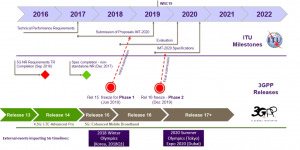The 5G standardization process is complex and highly innovative. 5G standards are developed in the 3rd Generation Partnership Project (3GPP), ITU Radiocommunication Sector (ITU-R), ITU Telecommunication Standardization Sector (ITU- T), the Internet Engineering Task Force (IETF) and IEEE. Here we focus on activities within 3GPP.

1.3GPP 5G will expand the LTE platform for new services while improving its efficiency to meet the mobile broadband demand.
2.3GPP 5G is not only a new radio (NR) interface but a full system, integrating LTE and NR radio access technologies with a 5G Core Network
- Initially, some of the use cases will be fulfilled by LTE, but the aim is to eventually fulfill all the requirements with NR
- From Release 15 onwards, the 3GPP specifications (LTE, NR and Core Network) will be marked “5G”
5.5G expands offerings by specializing radio and network capabilities (vertical sectors):
– Enhanced Mobile Broadband
– Massive Internet of Things
– Ultra-Reliable & Low Latency
Recent 3GPP 5G Developments
- In September 2017 3GPP RAN plenary re-enforced the timeline commitment for 5G development set out in March 2017.
- The focus for the “early drop” (December 2017) – Focus on LTE-anchored LTE-NR Dual Connectivity (DC) – Nonstandalone (NSA) NR – Several functions moved beyond December 2017
- Focus for the full Release 15 in June 2018: Standalone (SA)NR with new 5G Core
–NSA and SA share common 5G NR physical layer specifications for the air interface, and, thus, these aspects were covered in the December 2017 milestone.
–The main focus for the SA standardization is on the upper layers with full user and control plane capability and on the next-generation core network architecture, including network slicing.
According to the plan of 3GPP, 5G standards are divided into NSA (Non-Standalone) and SA (Standalone). Among them, the Non-Standalone, which is to say the 5G networks will be supported by existing 4G infrastructure.
5G SA and NSA Standard
The 5G SA Standard
More than 600 delegates from the world’s major telecom operators, network, terminals and chipset vendors, internet companies and other vertical industry companies have witnessed this historic moment for 5G.
As the Release 15 work has matured and drawn close to completion, the group’s focus is now shifting on to the first stage of Release 16, often referred to informally as ‘5G Phase 2’. Among them, R15 mainly meets the application needs of Enhanced mobile broadband (eMBB) and Ultra-Reliable Low-Latency Communication (URLLC). This stage is divided into two sub-stages. The first sub-stage 5G NR (New Radio) NSA feature was completed in December 2017 and frozen in March 2018. The second sub-phase, 5G NR standard, was completed in June 2018 and frozen in September.
The formulation of 5G NR standard means that the deployment standard of the whole 5G network has been improved, which will lead the industry to realize the commercialization of 5G communication and serve as the core infrastructure for the fourth industrial revolution in the future. As the first phase of 5G international standard, R15 can realize all the new features of 5G, which is conducive to giving full play to the full capacity of 5G. It is a truly commercially-oriented 5G standard and has some synergies with the final version of 5G R16 standard.
The 5G NSA Standard
Previously, in order to support national and national operators to achieve pre-commercialization of 5G in 2019, 3GPP completed 5G NSA standard ahead of schedule in December 2017 to support operators to carry out 5G mobile broadband business on the basis of the existing 4G core network. The released SA standard completes the 5G core network architecture and realizes 5G independent networking. SA standard can achieve the characteristics of 5G such as high reliability, ultra-low time delay and high efficiency, which is the core attribute of 5G to penetrate into the medical, industrial Internet, Internet of vehicles and other industries.
Conclusion
5G is a key milestone in the history of optical communication. For 5G optical networks, there is a huge market with so many challenges. Gigalight will keep providing customers with high-speed optical interconnection products with innovative designs and leading solutions.
Gigalight has launched a series of industrial-grade optical transceivers such as 25G BiDi SFP28 LR, 25G CWDM SFP28 LR,25G DWDM SFP28 optical transceivers for 10km/20km applications in the 5G fronthaul network, and 100GBASE-LR4/4WDM-40 QSFP28 modules along with 200G QSFP56 LR4 used for 10km applications in 5G midhaul (and backhaul) network. At the same time, we also offer industrial-grade passive optical components such as 5G OMUX, CCWDM, and AAWG.